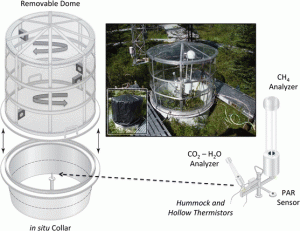A paper led by Paul Hanson from Oak Ridge National Laboratory on reporting CO2 and CH4 flux in a Minnesota peatland has been published in Biogeochemistry. Xiaofeng Xu is one of the coauthors. The paper reports the first few years of CO2 and CH4 fluxes under pretreatment condition with a community-scale collar approach.
Peatland measurements of CO2 and CH4 flux were obtained at scales appropriate to the in situ biological community below the tree layer to demonstrate representativeness of the spruce and peatland responses under climatic and environmental change (SPRUCE) experiment. Surface flux measurements were made using dual open-path analyzers over an area of 1.13 m2 in daylight and dark conditions along with associated peat temperatures, water table height, hummock moisture, atmospheric pressure and incident radiation data. Observations from August 2011 through December 2014 demonstrated seasonal trends correlated with temperature as the dominant apparent driving variable. The S1-Bog for the SPRUCE study was found to be representative of temperate peatlands in terms of CO2 and CH4 flux. Maximum net CO2 flux in midsummer showed similar rates of C uptake and loss: daytime surface uptake was −5 to −6 µmol m−2 s−1 and dark period loss rates were 4–5 µmol m−2 s−1 (positive values are carbon lost to the atmosphere). Maximum midsummer CH4-C flux ranged from 0.4 to 0.5 µmol m−2 s−1 and was a factor of 10 lower than dark CO2–C efflux rates. Midwinter conditions produced near-zero flux for both CO2 and CH4 with frozen surfaces. Integrating temperature-dependent models across annual periods showed dark CO2–C and CH4–C flux to be 894 ± 34 and 16 ± 2 gC m−2 y−1, respectively. Net ecosystem exchange of carbon from the shrub-forb-Sphagnum-microbial community (excluding tree contributions) ranged from −3.1 gCO2–C m−2 y−1 in 2013, to C losses from 21 to 65 gCO2–C m−2 y−1 for the other years.


